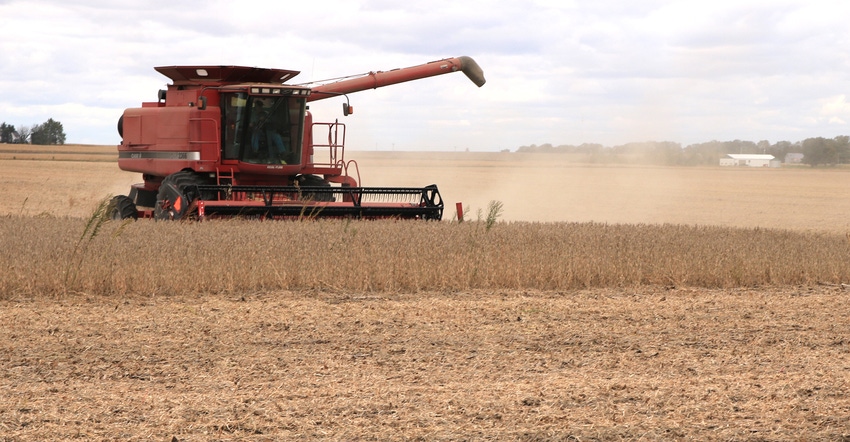October 21, 2019

U of I requests in-season, harvest data
Farmers explored uncharted territory in 2019 when planting stretched into June and even July in some locations in Illinois. While planting date data is available to researchers such as Emerson Nafziger, University of Illinois professor emeritus, he and his team also want in-season insights from farmers on the unique season.
Nafziger says farmers have a chance not to write this year off as a fluke, but rather to understand how this unplanned and involuntary experiment conducted by Illinois growers impacted yields. The idea is to collect a small amount of data for a large number of fields.
Farmers are asked to share the following information about one field: farmer background information, the county, the crop, planting date, relative maturity rating for corn or soybean maturity group for beans, yield and harvest moisture. Information on weather or management can be added, but this is optional.
Growers can submit their information by printing a copy of the survey and emailing it to Chelsea Harbach at [email protected]. There’s also an online form, which can be submitted multiple times for multiple fields. The goal is to collect all data by Dec. 31.
Emerson says they are looking for data across a wide range of planting dates and not just from fields that were planted late. He says if a field has spots that were drowned out and thus have no yield, either do not use the data or estimate the yield from the yield monitor based on parts of the field that had good stands.
Preparing for fall-applied N
In reflecting on an anhydrous ammonia spill north of Chicago in April that left emergency responders injured because they didn’t know what they were walking into, the Illinois Fertilizer and Chemical Association says applicators should try to prepare for another rushed anhydrous ammonia fall application season.
Every time there’s a release of 18 gallons (100 pounds) or more, the person in possession of the ammonia must call the proper authorities within 15 minutes of the release, with the first call being made to the Illinois Emergency Management Agency at 800-782-7860.
Safety reminders for transporting on roadways include:
2 max. Pull no more than two ammonia trailers in tandem behind a truck or one ammonia trailer behind a tractor and toolbar.
25 mph. Drive no more than 25 miles per hour when pulling ammonia tanks.
Amber light. Towing vehicles or implements of husbandry must be equipped with an amber rotating or flashing light between sunset and sunrise.
Secure. When transporting ammonia tanks on any roadway, always shut off all valves on the tanks and disconnect any transfer hoses between the toolbar and tank. Secure all hoses to the parking plug on the toolbar.
Prepare. Always use proper personal protection equipment and make sure each nurse tank has 5 gallons of fresh, clean water.
ILSoyAdvisor hosts webinar
In the next ILSoyAdvisor webinar by the Illinois Soybean Association, presenter Matt Montgomery of Pioneer will evaluate the 2019 growing season and discuss different management practices, including planting dates, row spacing and seed treatments.
The webinar, “Recent Experiences: What They Remind Us About Raising Beans,” is Nov. 14 at 10 a.m. One continuing education unit in crop development is available to qualified certified crop advisers. Learn more and register online.
Pork checkoff hosts social media training
Pig farmers, agriculturists and college students can attend the pork checkoff program’s social advocate training by registering before Nov. 12. The one-day training session starting at 9 a.m. on Nov. 26 covers the foundations of social media and more.
Hosted at the Illinois Pork Producers Association office in Springfield, 6411 S. 6th St., the event will also teach farmers and ag advocates about how they can take better pictures with their phone, use available apps and create the most appropriate responses.
Apple orchards meet less disease pressure in 2019
University of Illinois plant pathologist Mohammad Babadoost says 2019 was a good year for apple farmers, especially those growing Honeycrisp. As the new variety came to dominate the market in recent years, however, growers discovered a weakness.
“It’s a very popular, pricey and great apple, but Honeycrisp is so susceptible to bitter rot, which can wipe out an entire crop,” Babadoost says.
Bitter rot is a fungal disease that affects fruit in the late summer. The disease was rampant in central and southern Illinois orchards in 2018, particularly in Honeycrisp, Empire, Gala and several other varieties. In some cases, growers experienced almost 100% losses. The 2019 season was better, especially for growers in northern Illinois, but Babadoost didn’t want to leave anything to chance for future seasons.
“We set up an experiment at the University of Illinois Fruit Research Farm in Urbana, and it turned out excellent,” Babadoost says. “We identified some good fungicides that are less harmful to applicators and the environment, and they’re very effective against all fruit rots.”
Because there is no resistance to bitter rot or its cousins, white rot and black rot, fungicides and cultural controls are the only option. Babadoost’s research also tested cultural control methods, including removing wood piles, as well as apple mummies on the ground and on the tree. These efforts were highly successful.
“With both control methods, I’m hoping we will bring this disease under control,” Babadoost says.
He is optimistic, but emphasizes that his results are only from a single year and orchard. He plans to apply the practices in commercial orchards next year.
Babadoost will present his results this winter throughout Illinois, including at the Illinois Specialty Crops, Agritourism, and Organic Conference in January. He will also present at the Southern Illinois Fruit and Vegetable School in February. See additional information on this event and others.
You May Also Like




